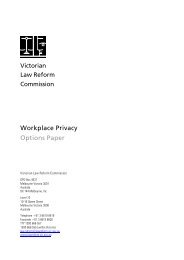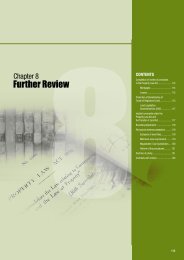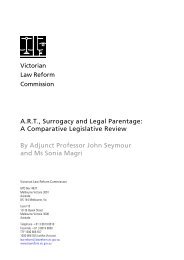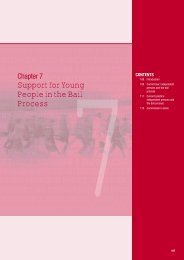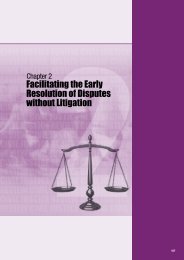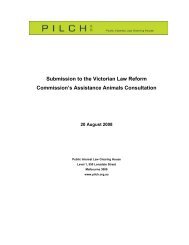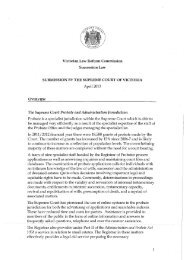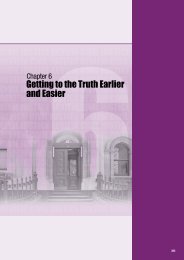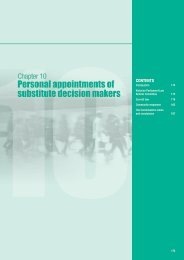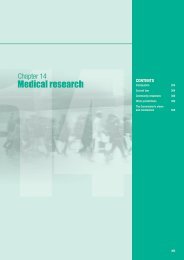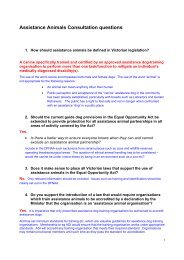12Facilitating Ongoing Civil Justice Review and Reform
12Facilitating Ongoing Civil Justice Review and Reform
12Facilitating Ongoing Civil Justice Review and Reform
You also want an ePaper? Increase the reach of your titles
YUMPU automatically turns print PDFs into web optimized ePapers that Google loves.
1. INTRODUCTION<br />
‘Managing justice is an ongoing process. There is no simple, once <strong>and</strong> for all solution to<br />
the problems of civil justice systems, no single best practice for managing or resolving<br />
disputes.’ 1<br />
Our terms of reference ask us to have regard to the aims of the Attorney-General’s <strong>Justice</strong> Statement:<br />
New directions for the Victorian <strong>Justice</strong> System 2004–2014, <strong>and</strong> in particular the modernisation,<br />
simplification <strong>and</strong> harmonisation of the rules of civil procedure within <strong>and</strong> across jurisdictions.<br />
The Attorney-General’s <strong>Justice</strong> Statement identified the following potential areas for procedural reform<br />
(among others):<br />
• <strong>Reform</strong> of the processes for commencing litigation. This may include common<br />
commencement forms between jurisdictions <strong>and</strong> the inclusion of the plaintiff’s statement<br />
of claim with the originating process.<br />
• The present variety of procedures in different jurisdictions, all of which fundamentally<br />
are directed at getting the parties to state their cases, identify issues in dispute <strong>and</strong><br />
disclose relevant supporting information, adds to the costs of litigation <strong>and</strong> clouds the<br />
transparency of the processes. Greater harmony between the rules of all three Victorian<br />
court jurisdictions should be the goal, provided that this does not encumber the lower<br />
jurisdictions with processes more appropriate to more complex litigation.<br />
Our terms of reference also ask us to identify the process by which the courts, the legal profession <strong>and</strong><br />
other stakeholders can be fully involved in any further detailed review of the rules of procedure.<br />
In this chapter we examine the processes by which procedural rules are made <strong>and</strong> amended in Victoria<br />
<strong>and</strong> other jurisdictions, outline recent moves towards uniform rules of civil procedure, <strong>and</strong> consider<br />
mechanisms for ongoing review <strong>and</strong> reform of the rules of civil procedure.<br />
In the course of the present inquiry we received numerous submissions proposing reforms in areas<br />
outside the matters which have been taken up in stage 1. In this chapter we summarise these reform<br />
proposals. Some of these may be taken up in stage 2 of the present inquiry. Some may be matters for<br />
consideration by the proposed <strong>Civil</strong> <strong>Justice</strong> Council. Others may be implemented, either by legislation<br />
or rule change, without the need for further investigation.<br />
2. RULES AND RULE-MAKING POWERS<br />
2.1 Victoria<br />
The rules that govern civil procedure in Victorian courts are made by the courts themselves as<br />
subordinate legislation. The principal rules are as follows:<br />
• Supreme Court (General <strong>Civil</strong> Procedure) Rules 2005 (Chapter I)<br />
• County Court Rules of Procedure in <strong>Civil</strong> Proceedings 1999<br />
• Magistrates’ Court <strong>Civil</strong> Procedure Rules 1999.<br />
The rules of the Supreme <strong>and</strong> County Courts share a large number of common provisions, which<br />
the Supreme Court has noted ‘allows for a common jurisprudence in relation to the application of<br />
the rules’. 2 There are some distinctions between the rules, reflecting different case management<br />
approaches, <strong>and</strong> variations in jurisdiction. The Magistrates’ Court rules are simpler <strong>and</strong> shorter than<br />
those that apply in the other courts. The courts also issue practice notes <strong>and</strong> guidelines to ‘provide<br />
more detailed <strong>and</strong> specialised information on the practices adopted in specialist lists, procedures for<br />
certain types of applications or new Court initiatives’. 3<br />
1 ALRC, Managing <strong>Justice</strong>: A <strong>Review</strong> of<br />
The judges of the Supreme Court may make rules ‘on any matter relating to the practice <strong>and</strong><br />
procedure of the Court or the powers, authorities, duties <strong>and</strong> functions of the officers of the Court’. 4<br />
The judges of the County Court ‘may make rules for regulating <strong>and</strong> prescribing the pleading, practice<br />
<strong>and</strong> procedure of the court’. 5 In any case not provided for in the County Court Act or Rules, the<br />
general principles of practice <strong>and</strong> the rules observed in the Supreme Court may be adopted <strong>and</strong><br />
applied. 6 In the Magistrates’ Court, the Chief Magistrate, together with two or more Deputy Chief<br />
Magistrates, may jointly make rules of court ‘for or with respect to any matter relating to the practice<br />
<strong>and</strong> procedure of the Court in civil proceedings’. 7<br />
the Federal <strong>Civil</strong> <strong>Justice</strong> System, Report<br />
No 89, (2000) [1.14].<br />
2 Submission CP 58 (Supreme Court of<br />
Victoria).<br />
3 Submission CP 58 (Supreme Court of<br />
Victoria).<br />
4 Supreme Court Act 1986 s 25.<br />
5 County Court Act 1958 s 78.<br />
6 County Court Act 1958 s 78(5).<br />
7 Magistrates Court Act 1989 s 16.<br />
697



